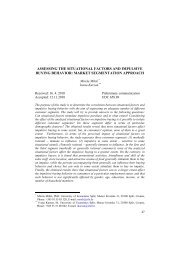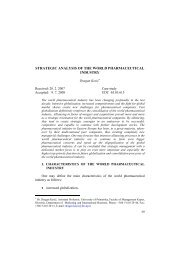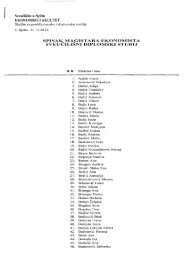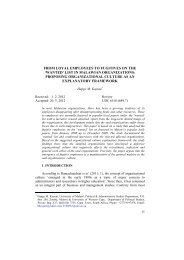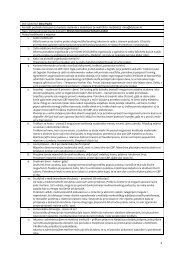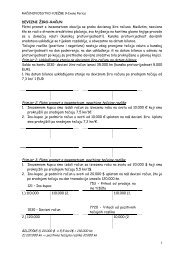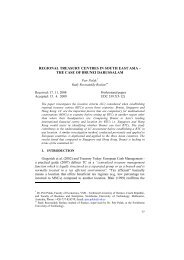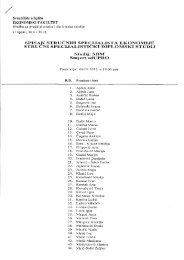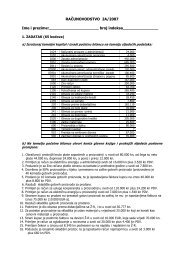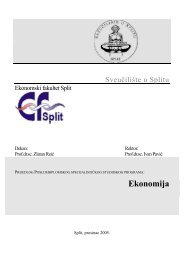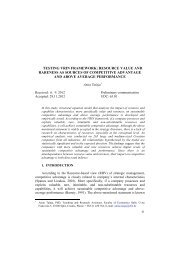the impact of the organisational structure and project organisational ...
the impact of the organisational structure and project organisational ...
the impact of the organisational structure and project organisational ...
Create successful ePaper yourself
Turn your PDF publications into a flip-book with our unique Google optimized e-Paper software.
Management, Vol. 16, 2011, 2, pp. 1-22<br />
A. Stare: The <strong>impact</strong> <strong>of</strong> <strong>the</strong> organizational <strong>structure</strong> <strong>and</strong> <strong>project</strong> organizational culture…<br />
The functional organisation is <strong>the</strong> classical organisation <strong>and</strong> consists <strong>of</strong><br />
purchasing, HRM, production, sales, finance department, etc. If a company<br />
starts such a <strong>project</strong>, this <strong>structure</strong> is unsuitable unless some changes are<br />
introduced. Employees from different departments are required to undertake<br />
additional <strong>project</strong> tasks, while <strong>the</strong> <strong>project</strong>’s management is assigned to a person<br />
within <strong>the</strong> functional organisation. All <strong>project</strong> activities, including management,<br />
represent additional tasks. The advantage <strong>of</strong> this solution is that nothing<br />
changes within <strong>the</strong> existing <strong>organisational</strong> <strong>structure</strong> by <strong>the</strong> introduction <strong>of</strong> such<br />
<strong>project</strong>s. The main disadvantage is that team members always give priority to<br />
<strong>the</strong>ir usual or functional duties. We can argue that this solution is appropriate in<br />
<strong>the</strong> case <strong>of</strong> starting a few <strong>project</strong>s.<br />
In <strong>the</strong> case <strong>of</strong> a <strong>project</strong>-based organisation, <strong>the</strong> <strong>project</strong> is assigned to a<br />
group <strong>of</strong> employees who are organised within a new department. Members <strong>of</strong><br />
<strong>the</strong> <strong>project</strong> team only work on <strong>project</strong> tasks; thus, being occupied with o<strong>the</strong>r<br />
regular activities is no excuse. The <strong>project</strong> manager, with <strong>the</strong> same authority as<br />
line managers, is responsible solely for <strong>the</strong> <strong>project</strong> <strong>and</strong> <strong>the</strong>re is no need for cooperation<br />
with line managers. Strong team work exists in <strong>the</strong> department. The<br />
main disadvantages are team members who are not fully occupied, <strong>the</strong> reduced<br />
connection <strong>of</strong> team members with <strong>the</strong> business functions, <strong>and</strong> <strong>the</strong> problem <strong>of</strong><br />
employment after <strong>the</strong> <strong>project</strong> finishes.<br />
The <strong>project</strong> matrix <strong>structure</strong> is a combination <strong>of</strong> <strong>the</strong> above-mentioned<br />
<strong>structure</strong>s. Every employee can carry out <strong>the</strong>ir regular activities within <strong>the</strong><br />
business function <strong>and</strong>, at <strong>the</strong> same time, be assigned to <strong>the</strong> <strong>project</strong> to conduct<br />
some unique <strong>project</strong> activities. The member is thus subordinated to <strong>the</strong> line<br />
manager (for <strong>the</strong>ir regular work) <strong>and</strong> to <strong>the</strong> <strong>project</strong> manager. The matrix<br />
<strong>structure</strong> is characterised by <strong>the</strong> simultaneous presence <strong>of</strong> both <strong>project</strong> <strong>and</strong><br />
functional components. These components are administratively independent,<br />
but interdependent in <strong>the</strong> execution <strong>of</strong> <strong>project</strong>s. This arrangement permits<br />
functional components to maintain an independent existence <strong>and</strong> to pursue <strong>the</strong>ir<br />
regular activities, while providing <strong>the</strong> specialised resources needed for <strong>the</strong><br />
execution <strong>of</strong> <strong>project</strong>s. In general, <strong>the</strong> specialists remain permanently under <strong>the</strong><br />
authority <strong>of</strong> <strong>the</strong> line managers, but <strong>the</strong>ir services are lent out to <strong>the</strong> <strong>project</strong>s on a<br />
temporary basis in line with <strong>project</strong> needs. The functional components thus<br />
become centralised reservoirs <strong>of</strong> specialised resources.<br />
The advantages <strong>of</strong> a matrix organisation include <strong>the</strong> more direct contact<br />
among different disciplines, <strong>the</strong> fact that people can work on a variety <strong>of</strong><br />
problems, a strong technical base can be developed, <strong>and</strong> much more time can be<br />
devoted to complex problem-solving, <strong>and</strong> shared authority <strong>and</strong> responsibility.<br />
10



